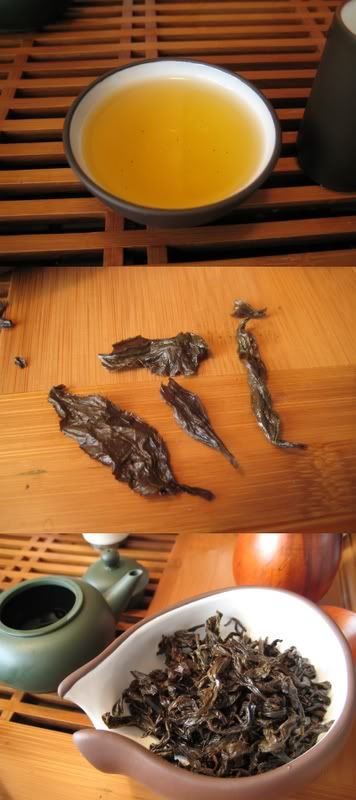 Class: Oolong
Class: OolongOrigin: Nantou county, Taiwan
Year: 1990's
Vendor: Hou De Asian Art (Product Page)
Price: ...oops, forgot to note this...
Verdict: 4.5/10
The label reads:
"A unique aged Formosa oolong that had been roasted for an extremely long time, usually taking months, following a unique roasting-quenching up-and-down pattern. Once finished, they were stored into jars for aging. No more re-roasting or drying is needed. Surprisingly warm character and smooth liquor. Slightly acid taste balances well with a licorice-like sweetness. Very good brewing strength."
Unlike the previous aged oolong I reviewed, this has undergone a different type of aging. While the 1980's Baozhong was periodically re-roasted every now and then as part of the aging process, this tea was roasted for months (!) and then stored, never to be roasted again.
The dry leaves show that this tea was once in the rolled-shape, though time seems to have shaken it up a bit. It seems a bit strange that this tea isn't completely black, considering it was roasted for months (again, !). I guess this just means it was a long, slow roast, though I can't eliminate the possibility that the aging has had some influence on the color's boldness.
The dry leaf reminds me of a breakfast pastry. In my ever-so-eloquent notes I wrote, "Chocolate, coffee, cream, cereal, honey. A pastry-like smell. Not very strong, but pleasant."
 Having previously brewed this with 5g of leaf in a 100mL gaiwan, I opted to change methods and use more leaf (6.1g) and a smaller Yixing pot (about 80-90mL) to see if I could squeeze out any more flavor. As you can see, the leaves filled the entire pot when wet. This is important because it means I couldn't have added any more leaf.
Having previously brewed this with 5g of leaf in a 100mL gaiwan, I opted to change methods and use more leaf (6.1g) and a smaller Yixing pot (about 80-90mL) to see if I could squeeze out any more flavor. As you can see, the leaves filled the entire pot when wet. This is important because it means I couldn't have added any more leaf.Why is that so important? This tea didn't have much strength at all, even when the teapot is packed with leaf and infusion times are stretched. There was very little body throughout, and a similar amount of flavor. What was there was good, but unsatisfying.
My notes are as follows:
Filtered tap water, just off the boil. Rinse, 18s, 31s, 28s, 31s, 33s
1: Wenxiangbei is light brown sugar, with a spicy cinnamon note. Liquor has a nice sweet/cinnamon aftertaste and hui gan, but that's about it. Not a lot of flavor except for a soft roast note and some honey. Almost no body. Watery.
2: Stronger roast flavor this time, though perhaps it is slightly overbrewed. The honey flavor is predominant, except for the harshness of the roast.
3: A slight bit of the classic aged, fruity character of aged oolong is found in the wenxiangbei. The fruit is hard to pin down... raisins, maybe? The same is found in the liquor. It's a strange flavor... it has the characteristic aged taste, but without anything to accompany it except some roast flavor. I guess the honey noted earlier isn't strong enough to compete.
4: Same as last time, but less flavorful.
5: Same as previous.
I wonder, is this tea just past its prime? Did it go stale? Would another roast reawaken it at all? Perhaps I'll save some for when I work up the courage to try roasting tea again. I've only tried it once before, and let's just say I ended up with some very expensive charcoal. For now, though, I would rate this tea a 4.5/10.


No comments:
Post a Comment
Note: Only a member of this blog may post a comment.